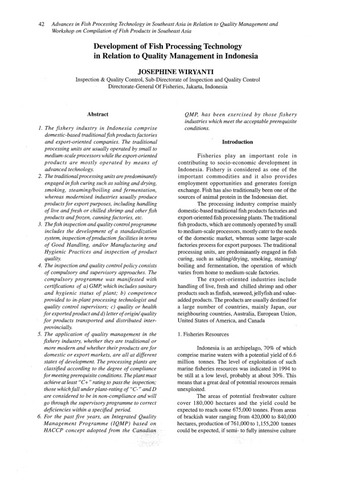| dc.contributor.author | Wiryanti, Josephine | |
| dc.contributor.editor | Hooi, Kok Kuang | |
| dc.contributor.editor | Low, Lai Kim | |
| dc.contributor.editor | Lim, Pang Yong | |
| dc.date.accessioned | 2019-05-27T09:11:05Z | |
| dc.date.available | 2019-05-27T09:11:05Z | |
| dc.date.issued | 1997 | |
| dc.identifier.citation | Wiryanti, J. (1997). Development of fish processing technology in relation to quality management in Indonesia. In K. K. Hooi, L. K. Low, & P. Y. Lim (Eds.), Proceedings of the seminar on the advances in fish processing technology in Southeast Asia in relation to quality management, Singapore, 29 October - 1 November 1996 (pp. 42-49). Singapore: Marine Fisheries Research Department, Southeast Asian Fisheries Development Center. | en |
| dc.identifier.isbn | 9810088639 | |
| dc.identifier.uri | http://hdl.handle.net/20.500.12066/4828 | |
| dc.description.abstract | 1. The fishery industry in Indonesia comprise domestic-based traditional fish products factories and export-oriented companies. The traditional processing units are usually operated by small to medium-scale processors while the export-oriented products are mostly operated by means of advanced technology.
2. The traditional processing units are predominantly engaged in fish curing such as salting and drying, smoking, steaming/boiling and fermentation, whereas modernised industries usually produce products for export purposes, including handling of live and fresh or chilled shrimp and other fish products and frozen, canning factories, etc.
3. The fish inspection and quality control programme includes the development of a standardization system, inspection of production facilities in terms of Good Handling, and/or Manufacturing and Hygienic Practices and inspection of product quality.
4. The inspection and quality control policy consists of compulsory and supervisory approaches. The compulsory programme was manifested with certifications of a) GMP, which includes sanitary and hygienic status of plant; b) competence provided to in-plant processing technologist and quality control supervisors; c) quality or health for exported product and d) letter of origin/ quality for products transported and distributed inter-provincially.
5. The application of quality management in the fishery industry, whether they are traditional or more modem and whether their products are for domestic or export markets, are all at different states of development. The processing plants are classified according to the degree of compliance for meeting prerequisite conditions. The plant must achieve at least "C+" rating to pass the inspection; those which fall under plant-rating of C- and D are considered to be in non-compliance and will go through the supervisory programme to Correct deficiencies within a specified period.
6. For the past five years, an Integrated Quality Management Programme (IQMP) based on HACCP concept adopted from the Canadian QMP, has been exercised by those fishery industries which meet the acceptable prerequisite conditions. | en |
| dc.language.iso | en | en |
| dc.publisher | Marine Fisheries Research Department, Southeast Asian Fisheries Development Center | en |
| dc.subject | Indonesia | en |
| dc.title | Development of fish processing technology in relation to quality management in Indonesia | en |
| dc.type | Conference paper | en |
| dc.citation.spage | 42 | |
| dc.citation.epage | 49 | |
| dc.citation.conferenceTitle | Proceedings of the Seminar on the Advances in Fish Processing Technology in Southeast Asia in Relation to Quality Management, Singapore, 29 October - 1 November 1996 | en |

